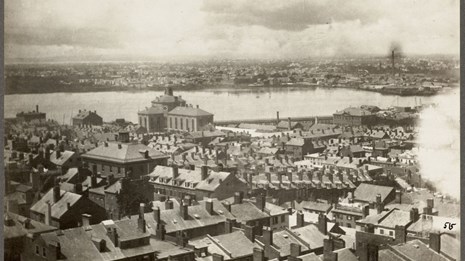Last updated: December 20, 2024
Person
George W. Houghton
Boston merchant George W. Houghton may have served on the 1850 Boston Vigilance Committee.
In his memoir, Reminiscences of Fugitive Slave Law Days in Boston, Austin Bearse recorded the name George W. Houghton in his "Doorman's List" of members of the Boston Vigilance Committee, an organization that aided freedom seekers on the Underground Railroad. Bearse watched the doors of Vigilance Committee meetings and only allowed known members in. Though Bearse did not provide any further identifying details, the George W. Houghton that he listed is most likely the Boston merchant George W. Houghton who resided in nearby Melrose in 1850. Aside from appearing on Bearse's list, however, Houghton's contributions to the Vigilance Committee remain unknown.1
Born in 1809 in Stillwater, New York, George W. Houghton later learned the printing trade in Vermont. He "engaged in newspaper work" in Connecticut and Cambridge, Massachusetts, before switching professions and becoming a trader in wholesale dry goods. He married his first wife Julina in 1835, and upon her death in 1884, married Abbie Susan Hubbard.2
While living in the Boston area, Houghton became an early member of Brook Farm, an experimental community inspired by Transcendentalism in West Roxbury. He even signed the constitution which established the community. Brook Farm attracted many radical thinkers and abolitionists and had connections with other Vigilance Committee members as well, including William H. Channing, Lemuel Capen, and Bronson Alcott.3
In 1851, however, Houghton left Massachusetts and moved to Lebanon, New Hampshire. He continued to engage in the mercantile business until ill health forced him into early retirement.
He passed away in 1900 and his remains are interred at School Street Cemetery in Lebanon.4
If you are a researcher or descendant of George W. Houghton and can provide any further details of his work with the Boston Vigilance Committee, please e-mail us.
Footnotes
- NPS maps geologcate George W. Houghton at the approximate address of his work in 1850: 6 Tremont Row. Austin Bearse, Remininscences of Fugitive Slave Law Days in Boston (Boston: Warren Richardson, 1880), 4; George Adams, Boston City Directory, 1850-1851, 194: Note, there is only one George W. Houghton listed in the 1850 Directory; The National Archives in Washington, DC; Record Group: Records of the Bureau of the Census; Record Group Number: 29; Series Number: M432; Residence Date: 1850; Home in 1850: Melrose, Middlesex, Massachusetts; Roll: 324; Page: 291a, Source Information: Ancestry.com. 1850 United States Federal Census [database on-line]. Lehi, UT, USA: Ancestry.com Operations, Inc., 2009. Images reproduced by FamilySearch.
- "Lebanon,"
Vermont Journal, January 27, 1900, 5; William Richard Cutter, Historic homes and places and genealogical and personal memoirs relating to the families of Middlesex County, Massachusetts (New York: Lewis Historical Publishing Company, 1908), 688; "George W. Houghton," Find a Grave Memorial, accessed December 2024. - Clarence L.F. Gohdes, The Periodicals of American Transcendentalism (Durham: Duke University Press, 1931), 102, Internet Archive; "Recent Deaths," Times Union, January 20, 1900, 2.
- "Lebanon," Vermont Journal, January 27, 1900, 5; "George W. Houghton," Find a Grave Memorial, accessed December 2024.






